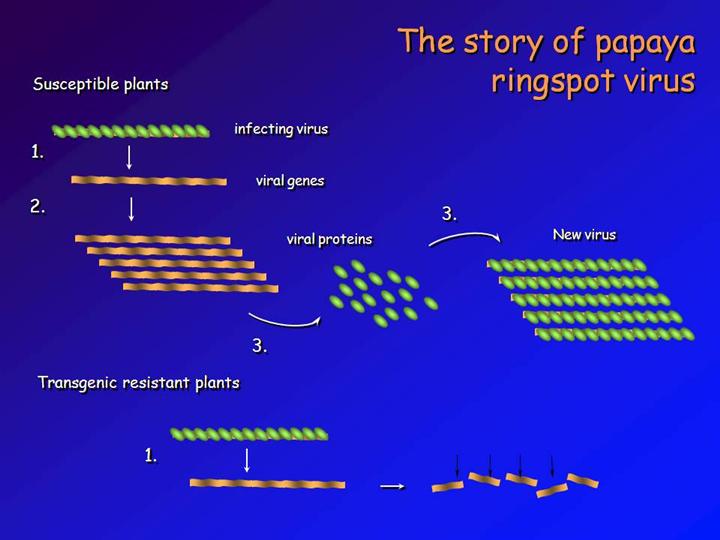 |
To me,
this is as remarkable a story as the history of vaccination in medicine.
And indeed, carrying the viral gene in essence “vaccinates” the papaya plant
against the virus, only by a very different mechanism, which has only been
understood recently. Here’s how it works. A virus is simply a packet of
genes in a protein coat (coat proteins are represented by green ovals). The
first thing that happens when a virus is delivered into a plant cell by an
insect is that the coat proteins are destroyed (1). This releases the
genes, which comandeer the cellular machinery, reprogramming it to make lots
more copies of the genes themselves, represented by the wavy bars (2).
These then makes lots of new coat proteins (3) that then coat the viral
genes to make new virus particles (4), waiting to be picked up by a new
insect. Meanwhile, they’ve pretty much wrecked the cells in which they
replicate, eventually killing the whole tree. In transgenic resistant
plants, the first step is the same: the virus takes takes off its coat
protein. But in the transgenic plants, the invading viral genes are
recognized , and destroyed, preventing the virus from reproducing. Is this
something that happens in nature? Yes. It is exactly how plants become
immune to viral infection -- very similar to how you become immune to a
disease once you’ve had it. The next time it sees the same virus, your
immune system recognizes it and destroys it. So it is with plants: once
they’ve been infected by a virus, this mechanism allows them to resist
reinfection. What Gonsalves and his colleagues did, then, was figure out
how to make the papaya trees immune to the ringspot virus by expressing just
a little piece of the virus’s genetic information in the plant to make it
think it had once been infected -- even though it hadn’t been. He is
considered a hero by the local farmers and has received national and
internaltional awards for this work. But he has also been attacked and
villified for this work by people and groups who are against GMOs. |
